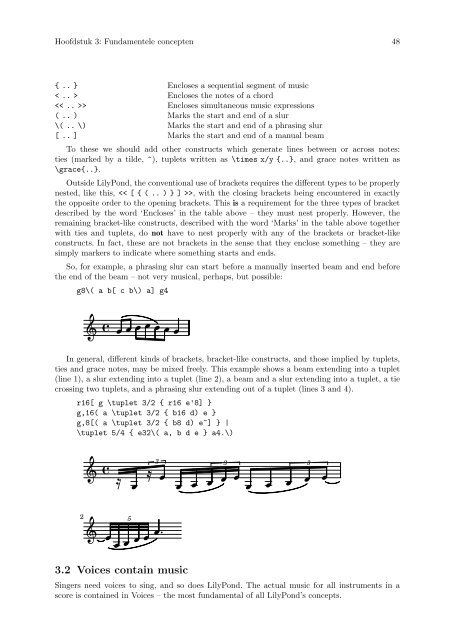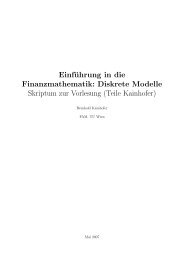LilyPond Beginnershandleiding
LilyPond Beginnershandleiding
LilyPond Beginnershandleiding
You also want an ePaper? Increase the reach of your titles
YUMPU automatically turns print PDFs into web optimized ePapers that Google loves.
Hoofdstuk 3: Fundamentele concepten 48<br />
{ .. } Encloses a sequential segment of music<br />
< .. > Encloses the notes of a chord<br />
> Encloses simultaneous music expressions<br />
( .. ) Marks the start and end of a slur<br />
\( .. \) Marks the start and end of a phrasing slur<br />
[ .. ] Marks the start and end of a manual beam<br />
To these we should add other constructs which generate lines between or across notes:<br />
ties (marked by a tilde, ~), tuplets written as \times x/y {..}, and grace notes written as<br />
\grace{..}.<br />
Outside <strong>LilyPond</strong>, the conventional use of brackets requires the different types to be properly<br />
nested, like this, >, with the closing brackets being encountered in exactly<br />
the opposite order to the opening brackets. This is a requirement for the three types of bracket<br />
described by the word ‘Encloses’ in the table above – they must nest properly. However, the<br />
remaining bracket-like constructs, described with the word ‘Marks’ in the table above together<br />
with ties and tuplets, do not have to nest properly with any of the brackets or bracket-like<br />
constructs. In fact, these are not brackets in the sense that they enclose something – they are<br />
simply markers to indicate where something starts and ends.<br />
So, for example, a phrasing slur can start before a manually inserted beam and end before<br />
the end of the beam – not very musical, perhaps, but possible:<br />
g8\( a b[ c b\) a] g4<br />
<br />
<br />
<br />
In general, different kinds of brackets, bracket-like constructs, and those implied by tuplets,<br />
ties and grace notes, may be mixed freely. This example shows a beam extending into a tuplet<br />
(line 1), a slur extending into a tuplet (line 2), a beam and a slur extending into a tuplet, a tie<br />
crossing two tuplets, and a phrasing slur extending out of a tuplet (lines 3 and 4).<br />
r16[ g \tuplet 3/2 { r16 e'8] }<br />
g,16( a \tuplet 3/2 { b16 d) e }<br />
g,8[( a \tuplet 3/2 { b8 d) e~] } |<br />
\tuplet 5/4 { e32\( a, b d e } a4.\)<br />
2<br />
<br />
<br />
<br />
<br />
3 3 3<br />
<br />
<br />
<br />
<br />
<br />
3.2 Voices contain music<br />
<br />
5<br />
<br />
<br />
<br />
<br />
Singers need voices to sing, and so does <strong>LilyPond</strong>. The actual music for all instruments in a<br />
score is contained in Voices – the most fundamental of all <strong>LilyPond</strong>’s concepts.



